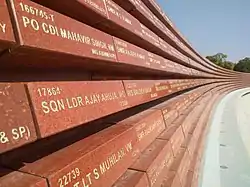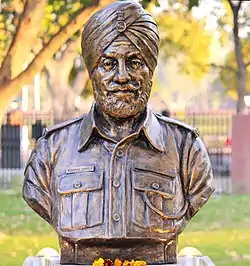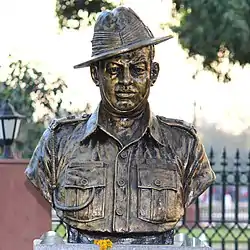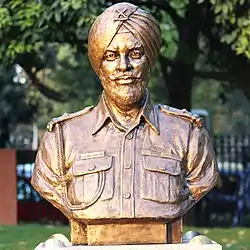National War Memorial (India)
The National War Memorial (Hindi: राष्ट्रीय समर स्मारक, romanized: Rāshtrēy Samar Smārak) is an Indian national monument built to honour and remember soldiers of the Indian military who gave the supreme sacrifice in armed conflicts of Independent India. The names of armed forces personnel killed during the armed conflicts with Pakistan and China as well as the 1961 War in Goa, Operation Pawan, and other operations such as Operation Rakshak are inscribed on the memorial walls in golden letters.[3]
| National War Memorial | |
|---|---|
राष्ट्रीय समर स्मारक | |
   (Clockwise from top) The Stambh (obelisk) houses the immortal flame, a section of the Tyag Chakra, view of a bust at the Param Vir Chakra section | |
| For Indian military dead of all wars | |
| Established | January 2019 |
| Unveiled | 25 February 2019 |
| Location | 28°36′46″N 77°13′59″E C Hexagon, India Gate Circle, New Delhi, India |
| Designed by | Yogesh Chandrahasan, WeBe Design Lab, Chennai |
| Statistics source: Official government website | |
This monument is spread over 40 acres of land and was built by the Government of India around the existing chhatri (canopy), near India Gate, New Delhi.[4] The memorial wall is flushed with the ground and in harmony with existing aesthetics.[5] It completed in January 2019 and was unveiled on 25 February 2019 in an inauguration ceremony held at the monument where the Prime Minister of India in the presence of CDS of India, and the 3 Chief of Staffs of Indian Armed Forces, ignited the eternal flame of Amar Jawan Jyoti (Flames of Eternal Soldiers) at Amar Chakra under the main obelisk of the monument.[6]
Architecture and design
National War Memorial
A global design competition was conducted and the result was announced in early April 2017. A Chennai architectural firm, WeBe Design Lab's proposal was declared the winner and was accordingly chosen for the conceptualization of the architectural design and for coordinating the construction of the project.[7] The chief architect of the National War Memorial is Yogesh Chandrahasan of WeBe Design Lab, Chennai. Chandrahasan, who designed the project, said:[8]
“The whole concept is based on the thought that the war memorial should be a place where we don’t mourn the death, but celebrate the life of the soldiers and pay respect to the sacrifices made by them.”
The National War Memorial and Museum was designated as a Special Project, and the task of its "timely execution" was allocated to a Special Projects Division under the Chief Administrative Officer (Ministry of Defence), and the Military Engineer Services.[9]
Concept
The Memorial has four concentric circles and a central obelisk, at the bottom of which burns an 'eternal flame' representing the immortal soldier (amar jawan).[4][10] The concentric circles are designed as a Chakravyuh, an ancient Indian war formation.[11] are called as follows (from innermost to outermost) :
- Amar Chakra (Circle of Immortality): This structure of the memorial derives its name from the Eternal Flame (Amar Jawan Jyoti), continuously burning under the main obelisk at the center of the monument. The flame symbolises the immortality of the spirit of fallen soldiers and the promise that the Nation will never forget their sacrifices.[12]
- Veerta Chakra (Circle of Bravery): The second circle depicts the Bravery of Indian forces in the form of a covered gallery that exhibits six murals crafted in bronze depicting valiant battle actions of Indian Armed Forces. The battles showcased here are Battle of Gangasagar, Longewala, Tithwal, Rizangla, Operation Meghdoot and Operation Trident.[12]
- Tyag Chakra (Circle of Sacrifice): The circular concentric walls of honour, which symbolise the ancient war formation ‘Chakravyuh’. The walls are clad with granite tablets where an independent granite tablet is dedicated to each soldier who has made the supreme sacrifice in the battlefield, where his name is etched in golden letters along with the details of Rank.[12]
- Rakshak Chakra (Circle of Protection): The outermost circle made of rows of trees in the Rakshak Chakra is a reassurance to the citizens of the country about their safety against any threat, with each tree representing the soldiers who ensure the territorial integrity of the Nation, round the clock.[12]
The Param Yodha Sthal houses the busts of all the 21 recipients of the Param Vir Chakra, India's highest military honour.[4]
(clockwise from top) Captain GS Salaria, Lance Naik Karam Singh, Major Dhan Singh Thapa, Naib Subedar Bana Singh, Major Somnath Sharma
National War Museum
A National War Museum will be constructed in the adjoining Princess Park area and will be connected to the memorial through an underground tunnel. The Princess Park is a 14-acres large area north of India Gate, with barrack-like accommodations built during World War II. Since 1947, it has served as family accommodation for mid-level armed forces officers posted in the Service Headquarters in New Delhi.[13] The proposed National War Museum will be connected by metro. The construction of the War Memorial and Museum is expected to cost ₹500 crore (US$70 million).[14]
In July 2020, the Central Public Works Department opened the tender for the selection of a consultant for the National War Museum in an area of around 10 acre. Two firms have been shortlisted, CP Kukreja Architects and Suresh Goel & Associates.[15]
Significance and celebrations
Republic Day old custom
Since 1972, every-year on the Republic Day (before the Republic Day parade), it had been customary for the President, Prime Minister, Chief of the Air Staff, Chief of the Naval Staff, Chief of the Army Staff and dignitaries to place wreath at Amar Jawan Jyoti and pay homage to the dead and unknown soldiers.[16][17][18][19]
Starting of a new custom
On the occasion of 71st Independence Day, the President of India, Ram Nath Kovind placed a wreath and observed 2 minutes silence to pay tribute to the soldiers on the occasion of 73rd Independence Day for the first time at newly inaugurated National War Memorial instead of Amar Jawan Jyoti under India Gate.[20] And this way started a new custom to honour the soldiers fallen for the country after Independence.
Following the custom set by the President in previous year, the Prime Minister of India, Narendra Modi, for the first time placed the Wreath at National War Memorial instead of India Gate on the occasion of Republic Day. Starting a new custom taking place at new Amar Jawan Jyoti under National War Memorial accompanied by the Chief of Defence Staff , along with Army Chief, Navy Chief, and Air Force Chief who also visits the same monument on respective Service Days to pay tribute to the fallen heroes of the nation, post Independence.[21][22]

Celebrations
- Republic Day, the Prime Minister visits and places a wreath followed by a two minute silence, accompanied by the Chief of Defence Staff (CDS) and the tri-service Chief of Staffs.[23][21]
- Independence Day, the President visits and places a wreath followed by a two minute silence, accompanied by the Chief of Defence Staff (CDS) and the tri-service Chief of Staffs.[22]
- Armed Forces Service Days, on the respective days of establishment of the tri-services, Army Chief, Navy Chief, and Air Force Chief collectively visits.
- Armed Forces Flag Day, the CDS accompanied by the three Chief of the Staffs collectively visit.
- Kargil Vijay Divas, celebration of success of Mission Vijay during Kargil war in 1999.
- Vijay Divas, celebration of victory of Indian troops over Pakistan.
Timeline
Pre Construction
- 1960 - The Indian Armed Forces first propose a national war memorial.[3]
- 2006 - In the face of persistent demand from the armed forces and veterans for a war memorial, the United Progressive Alliance (UPA) government constitutes a Group of Ministers' (headed by Pranab Mukherjee) to examine the demand.[24] In 2006, the Ministry of Defence decides that the war memorial should be set up in the vicinity of India Gate, but panels under the Ministry of Urban Development say that it is a heritage area and should not be built upon.[25]
- 20 October 2012 - After 50 years, the government marks the anniversary of the offensive by the Chinese People's Liberation Army against Indian border defences on 20 October 1962, by a solemn ceremony at the Amar Jawan Jyoti, to honour Indian soldiers killed in the 1962 war. At the ceremony, A. K. Antony (the Minister of Defence) announces that the government has conceded the long-standing demand of the Indian Armed Forces for a national war memorial, and that it will be built near India Gate. He adds that the group of ministers has cleared all outstanding issues on the matter and the armed forces will finally get their wish.[26][27] The Chief Minister of Delhi, Sheila Dikshit, opposes this plan.[24]
- February 2014 - In the build-up to the 2014 Lok Sabha elections, Narendra Modi speaks about how the previous government had failed to construct the war memorial.[28]
- 7 October 2015 - The Union Cabinet passes the proposal to build the war memorial. It also clears ₹500 crore for the memorial and museum, sanctioning ₹176 crore for the memorial alone.[29]
- May 2016 - The Union Cabinet is apprised of the decision taken by the Empowered Apex Steering Committee (EASC) that the Princess Park Complex would be the suitable site for construction of the National War Museum. The National War Memorial would be constructed at ‘C’ Hexagon of India Gate as approved by the Cabinet in its meeting held in October 2015.[30]
- 30 August 2016 - A global design competition for the National War Memorial and Museum is launched on the MyGov.in web portal.[31]
- April 2017 - The result of the global design competition is announced. Mumbai-based sP+a Studio's proposal wins for the design of the National War Museum. Chennai-based WeBe Design Lab's proposal is declared the winner for the design of the memorial.[28] A total of 427 submissions are received for the "Global Design Competition for National War Memorial" while 268 submissions are received for the "Global Architectural Competition for Indian National War Museum".[32][33] The jury was led by architect and planner Christopher Benninger.[4]
- 15 August 2018 - The National War Memorial misses the first deadline for its inauguration.[3]
- 1 January 2019 - The National War Memorial's construction is complete (not of the museum).[3][34]
Post Construction
- 25 February 2019 - The National War Memorial is inaugurated.[35]
- 30 May 2019 - Narendra Modi visited National War Memorial and paid tribute to India's martyrs before taking oath as the Prime Minister of India for the second time.[36]
- 15 August 2019 - The President of India, Shri Ram Nath Kovind placed a wreath and observed 2 minutes silence to pay tribute to the soldiers on the occasion of 73rd Independence Day for the first time instead of India Gate.[20]
- 26 January 2020 - The Prime Minister, Narendra Modi placed a wreath and observed 2 minutes silence to pay tribute to the soldiers before the start of the 71st Republic Day Parade for the first time on Republic Day.[23]
- 23 July 2020 - Central Public Works Department opened the bid for selection of a consultant for the National War Museum.[15]
- 26 July 2020 - The 21st anniversary of Kargil Vijay Diwas, Defence Minister of India Shri Rajnath Singh accompanied by MoS (Defence) , the CDS and the tri-service chiefs paid tribute at NWM.[37]
- 15 August 2020 - The President of India, Shri Ram Nath Kovind placed a wreath and observed 2 minutes silence to pay tribute to the soldiers on the occasion of 74th Independence Day.
- 16 December 2020 - The Prime Minister, Narendra Modi paid tributes and started the celebration of Golden Jubilee Year of Indian victory over Pakistan by lighting a Swarnim Vijay Mashaal (Golden Victory Torch) with the fire from Amar Jawan Jyoti at NWM.[38]
Gallery
.jpg.webp) Floral decoration on the inauguration of the NWM
Floral decoration on the inauguration of the NWM A fountain at the NWM
A fountain at the NWM.JPG.webp) The Prime Minister lighting the eternal flame of the National War Memorial on February 25, 2019
The Prime Minister lighting the eternal flame of the National War Memorial on February 25, 2019 India Gate from the Memorial, Night lighting view
India Gate from the Memorial, Night lighting view A section of Tyag Chakra with names of the soldiers in golden letters
A section of Tyag Chakra with names of the soldiers in golden letters India Gate is visible in the background, Daytime view
India Gate is visible in the background, Daytime view National war memorial with lights, view after sunset
National war memorial with lights, view after sunset
See also
| Wikimedia Commons has media related to National War Memorial (India). |
- Amar Jawan Jyoti in New Delhi
- India Gate in New Delhi
- National Military Memorial in Bengaluru
- National War Memorial Southern Command in Pune
- War Heroes' Memorial & Museum in Amritsar
- Kargil Vijay Diwas
- Vijay Diwas (India)
- Bijoy Dibos
- Kumaon Regiment
References
- "National War Memorial". nationalwarmemorial.gov.in. Archived from the original on 31 March 2020. Retrieved 3 January 2021.
- "शहीदों के सम्मान पर 1916 में लिखी यह कविता आज भी मौजूं है". Aaj Tak आज तक (in Hindi). 15 February 2019. Retrieved 3 January 2021.
- Pandit, Rajat (1 January 2019). "Delhi: War memorial ready, 60 years after it was first proposed". The Times of India. Archived from the original on 3 January 2019. Retrieved 30 January 2019.
- Baruah, Sukrita (26 February 2019). "Explained: India's National War Memorial". The Indian Express. Retrieved 2 March 2019.
- Gokhale, Nitin A. (11 July 2014). "Fulfilling a sacred contract with the soldier". News Warrior. Retrieved 28 August 2014.
- "PM Modi inaugurates National War Memorial in New Delhi". The Hindu. PTI. 25 February 2019. ISSN 0971-751X. Retrieved 14 December 2020.CS1 maint: others (link)
- https://thewire.in/urban/national-war-museum-delhi-india-gate
- Das Gupta, Moushumi (28 April 2018). "War memorial near India Gate to be completed by Independence Day". Hindustan Times. Retrieved 4 March 2019.
- "Charter of Duties". Ministry of Defence. Retrieved 22 November 2016.
- Siddiqui, Huma (25 February 2019). "National War Memorial: India's tribute to her war heroes, see stunning pics". The Financial Express. Retrieved 2 March 2019.
- Yadav, Namrata (3 March 2019). "Are you looking for someone you lost, Ma'am? They asked my mother at National War Memorial". The Print. Retrieved 4 March 2019.
- "National War Memorial". www.nationalwarmemorial.gov.in. Retrieved 16 December 2020.
- "Budget 2014: India to finally get a national war memorial, Modi govt allocates Rs 100cr - Times of India". The Times of India. Retrieved 25 February 2019.
- "In Delhi, Army loses Lutyens territory; govt plans to build war museum, apartments in Princess Park - Economic Times". 21 January 2013. Retrieved 25 August 2014.
- Dutta, Anisha (11 August 2020). "Centre shortlists consultants for National War Museum". Hindustan Times. Retrieved 25 August 2020.
- "Amar Jyoti". discoveredindia.com. Retrieved 4 January 2017.
- "Amar Jawan Jyoti". indiagate.org.in. Retrieved 4 January 2017.
- "Significance of Amar Jawan Jyoti". indiagate.org.in. Retrieved 4 January 2017.
- "History". indiagate.org.in. Retrieved 4 January 2017.
- "Independence Day 2019 highlights: Pinarayi Vijayan, E Palaniswami, Jagan Mohan Reddy hoist tricolour in celebration of 73rd Independence Day - India News , Firstpost". Firstpost. 15 August 2019. Retrieved 14 December 2020.
- DelhiJanuary 23, India Today Web Desk New; January 23, 2020UPDATED:; Ist, 2020 16:22. "Not Amar Jawan Jyoti, Republic Day wreath-laying ceremony at National War Memorial from this year". India Today. Retrieved 14 December 2020.CS1 maint: extra punctuation (link) CS1 maint: numeric names: authors list (link)
- ANI. "President Kovind pays tribute at National War Memorial on Independence Day". BW Businessworld. Retrieved 14 December 2020.
- "Not Amar Jawan Jyoti, PM To Pay Homage At War Memorial On Republic Day". NDTV.com. Retrieved 14 December 2020.
- Nitin Gokhale (16 December 2012). "National war memorial - an unrealised dream". NDTV. Archived from the original on 28 August 2018. Retrieved 21 August 2014.
- P Sharma, Aruna (5 December 2006). "Ministry seeks new war memorial". Hindustan Times. Retrieved 30 January 2019.
- "In a first, nation pays homage to martyrs of 1962 Indo-China war". First Post. PTI. 20 October 2012. Retrieved 28 August 2014.
- http://www.newsx.com
- Bhatnagar, Gaurav Vivek (21 April 2018). "National War Memorial Takes Shape Six Decades After Being Conceived". The Wire. Archived from the original on 30 January 2019. Retrieved 30 January 2019.
- "Cabinet clears Rs. 500 crore for National War Memorial", The Hindu, 7 October 2015
- "Site for construction of National War Memorial and National War Museum - Press Information Bureau". Retrieved 27 August 2018.
- Press Information Bureau, Government of India, Ministry of Defence. "Global Design Competition for National War Memorial and Museum". Press Information Bureau. Archived from the original on 30 January 2019. Retrieved 30 January 2019.CS1 maint: multiple names: authors list (link)
- "Global Architectural Competition for Indian National War Museum". MyGov.in. 19 August 2016. Retrieved 30 January 2019.
- "Global Design Competition for National War Memorial". MyGov.in. 19 August 2016. Retrieved 30 January 2019.
- Alex Philip, Snehesh (7 January 2019). "National War Memorial to honour 22,600 soldiers set for R-Day eve inauguration". The Print. Retrieved 30 January 2019.
- Pandit, Rajat (3 February 2019). "National War Memorial to be finally inaugurated this month". The Times of India. Archived from the original on 3 February 2019. Retrieved 3 February 2019.
- "Ahead of oath-taking ceremony, PM Modi visits National War Memorial". WION. Retrieved 16 December 2020.
- "Kargil Vijay Diwas Live Updates: Enemy perched atop heights was defeated by brave soldiers, says PM Modi". The Indian Express. 26 July 2020. Retrieved 16 December 2020.
- Mehrotra, Vani (16 December 2020). "Vijay Diwas: PM Modi lights 'Swarnim Vijay Mashaal' at National War Memorial". www.indiatvnews.com. Retrieved 16 December 2020.
.jpg.webp)




